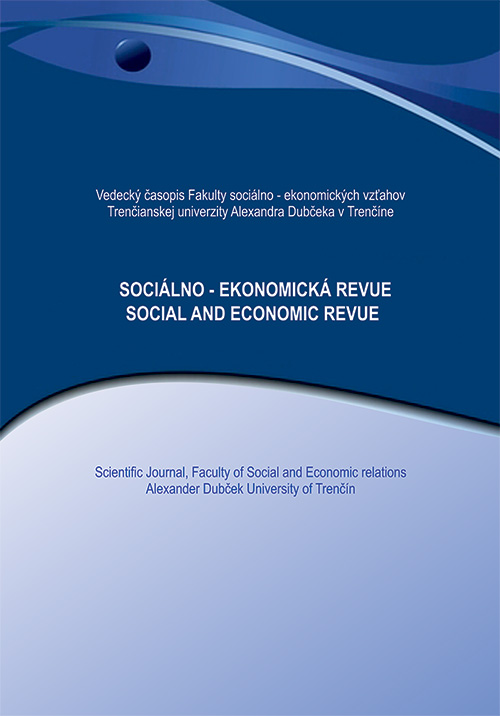COMPARISON OF NEURAL NETWORKS AND REGRESSION TIME SERIES IN ESTIMATING THE DEVELOPMENT OF THE AFTERNOON PRICE OF GOLD ON THE NEW YORK STOCK EXCHANGE
Gold is a very important commodity in today's global world. Therefore, the price of gold and its development is a fundamental question for many researchers. This paper aims to perform a regression analysis of the development of the afternoon price of gold on the New York Stock exchange using artificial neural networks and linear regression. Data from a period longer than ten years are used. This is a total of 2,578 pieces of data. We use linear regression with the linear, exponential, polynomial, logarithmic, numbers of weighted distances, multiple negative-exponential extermination and spline function. Multilayer perceptron neural networks and neural networks of the radial basis function are generated. A total of 1,000 neural structures are generated, 5 of those with the best characteristics are retained Regarding simple linear regression, the curve obtained via the spline function mirrors the development of the gold price best. However, better results are achieved by all 5 preserved neural networks.
Vydanie: 2020/1 Strany: 61-72 Klasifikácia JEL: C22, C45, C53
DOI:
Kľúčové slová: artificial neural networks, regression time series, prediction, gold price, commodity, future price development
Sekcia:
Kontakty:
Ing. Veronika Machová, MBA
School of Expertness and Valuation, The Institute of Technology and Business in České Budějovice
Okružní 517/10, 370 01 České Budějovice, Czech Republic
machova@mail.vstecb.cz
Ing. Tomáš Krulický, BBA
Faculty of Operation and Economics of Transport and Communications, University of Žilina
Univerzitná 8215/1, 010 26 Žilina, Slovakia
krulicky@mail.vstecb.cz
Ing. Jakub Horák
Faculty of Operation and Economics of Transport and Communications, University of Žilina
Univerzitná 8215/1, 010 26 Žilina, Slovakia
horak@mail.vstecb.cz
Literatúra:
Aye, G., Gupta, R., Hammoudeh, S., Kim, W. J. (2015). Forecasting the price of gold using dynamic model averaging. International Review of Financial Analysis, 41, 257-266.
Boguslauskas, V., Mileris, R. (2009). Estimation of Credit Risk by Artificial Neural Networks Model's. Engineering Economics, 64 (4), 7-14.
Chen, Y., Yang, B., Dong, J. (2006). Time-series prediction using a local linear wavelet neural network. Neurocomputing, 69 (4-6), 449-465.
Ferry, E. (2016). Gold prices as material-social actors: The case of the London Gold Fix. The Extractive Industries and Society, 3 (1), 82-85.
Gangopadhyay, K., Jangir, A., Sensarma, R. (2016). Forecasting the price of gold: An error correction approach. IIMB Management Review, 28 (1), 6-12.
Ghazali, H., Bahari, Z. (2013). Is gold a hedge or a safe haven? An empirical evidence of gold and stocks in Malaysia. International Journal of Business and Society, 14 (3), 428-443.
Hauptfleisch, M., Putniņš, T. J., Lucey, B. (2016). Who Sets the Price of Gold? London or New York. Journal of Futures Markets, 36 (6), 564-586.
Hu, Y. H., Hwang, J. N. (2002). Handbook of neural network signal processing. Boca Raton: CRC Press. ISBN 978-084-9323-591.
Reboredo, J. C., Ugolini, A. (2017). Quantile causality between gold commodity and gold stock prices. Resources Policy, 53, 56-63.
Santin, D. (2008). On the approximation of production functions: a comparison of artificial neural networks frontiers and efficiency techniques. Applied Economics Letters, 15 (8), 597-600.
Sánchez, D., Melin, P. (2015). Modular Neural Networks for Time Series Prediction Using Type-1 Fuzzy Logic Integration. Studies in Computational Intelligence, 141-145.
Sheikhan, M., Mohammadi, N., Tawfik, H., Ben-Jacob, E. (2013). Time series prediction using PSO-optimized neural network and hybrid feature selection algorithm for IEEE load data. Neural Computing and Applications, 23 (3-4), 1185-1194.
Stehel, V., Vrbka, J., Rowland, Z. (2016). Using neural networks for determining creditworthiness for the purpose of providing bank loan on the example of construction companies in South Region of Czech Republic. Ekonomicko-manažerské spektrum, 2016 (2), 62-73.
Vochozka, M., Stehel, V., Rowland, Z. (2019). Determining development of business value over time with the identification of factors. Ad Alta: Journal of Interdisciplinary Research, 9 (2), 358-363.
Vochozka, M. (2017). Comparison of neural networks and regression time series in estimating the development of the afternoon price of palladium on the New York Stock Exchange. Trends Economics and Management, 30 (3), 73-83.
World Bank. (2017). The World Bank. [on-line] [cit.: 2020-01-20]. Retrieved from http://www.worldbank.org/.
Zhu, H., Peng, C., You, W. (2016) Quantile behaviour of cointegration between silver and gold prices. Finance Research Letters, 19 (C), 119-125.


